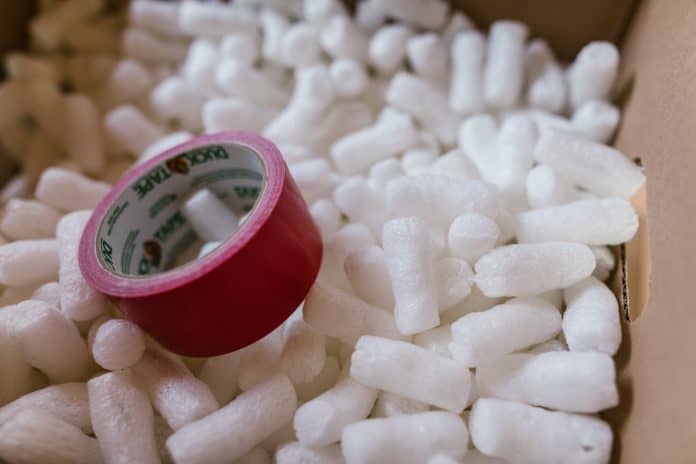Last updated on March 13th, 2023 at 03:59 pm
The current climate crisis is causing more companies to think about the impact their operations have on the planet, including the products and packaging they use.
Biodegradable and eco-friendly packaging materials are not the easiest to define because there are many options and few universal parameters. Putting more thought into your products’ best sustainable packaging design options can support our planet and benefit your business.
What are Biodegradable Packaging Materials Made Of?
Environmentally-friendly packaging is difficult to define because it depends on the context. As a rule, any packaging that causes less harm to humans, animals, and the environment could qualify as eco-friendly.
There are no standardizations or universal parameters for eco-friendly materials for packaging. As a general rule, these items should be either biodegradable or recyclable and designed not to harm the environment.
But what are biodegradable packaging materials made of? Here are some sustainable packaging examples:
- Recycled Cardboard/Paper – These materials have acted as sustainable materials for packaging for decades. You can make these packages at home by using many of the items you have around you. Recycled cardboard/paper is constantly used and reused while being biodegradable.
- Biodegradable Packing Peanuts – Switch from polystyrene peanuts to cornstarch peanuts for a biodegradable alternative to packing peanuts.
- Mushroom Packaging – Made from durable, non-toxic, and durable materials, mushroom packaging is second to none in terms of performance and customizability. These organic materials are grown from the earth, meaning you can throw the packaging on a compost heap later.
- Seaweed – Seaweed packaging is made from agar-agar, found in seaweeds and algae. It’s also used as an alternative to gelatin within the food industry. Agar can be used for capsules, bioplastics, and as one of the most innovative eco-friendly packaging ideas.
- Recycled/Upcycled Plastics – Recycled plastics can be considered eco-friendly if used and reused. For example, you can use bubble wrap repeatedly before it loses effectiveness. The same goes for poly bags.
Investing in packaging environmental products allows your organization to make a difference. Not every material has to be 100% biodegradable to contribute to a better earth. Committing to recycling nasty plastics is also a way of supporting the planet.

Why Use Recyclable Materials for Packaging?
While developing packaging strategies, you may wonder what other benefits come from adopting biodegradable packaging materials. We know that reducing waste lowers your carbon footprint and helps to save the environment. But what other advantages come from using recyclable materials for packaging?
- Cost-Savings – Reusing existing packaging means you can save money. It’s a common myth that opting for green options has to cost you more.
- Improve Your Reputation – Green issues are becoming increasingly important for consumers. Align your values with your customers to improve your reputation and show your support for the environment.
- Raising Brand Awareness – Positive changes for the environment can be leveraged in marketing to promote your brand online and offline.
- Generate Brand Loyalty – Customers are more likely to return if your values align with theirs. Adopting biodegradable packaging materials can increase the chances of creating more brand loyalty.
- Stay Versatile – Eco-friendly packaging offers the same versatility as legacy packaging. Enjoy the same level of branding and customization while helping to remove environmental toxins.
Your stakeholders may not be overly concerned with your business’s environmental impact, but there are tangible business benefits to going green. Now is the time to get them on board. With the climate emergency becoming ever more urgent, it has never been a better time to go green.
7 Sustainable Packaging Strategies
How can you best take advantage of biodegradable packaging materials?
Think about your supply chain and how you currently pack and transport your products. Lay out where you can improve by noting how much non-biodegradable material you’re using
Follow these sustainable packaging strategies to reduce your carbon footprint.
1. Ship in Smaller Packages
Decreasing your environmental impact begins by limiting how much material you use for packaging and shipping as much as possible. Use smaller boxes and fewer filler materials. You’ll be surprised at how little you need to keep your products safe during transit.
Play around with the positioning of your products to see if they can fit into smaller packages. Opting for less isn’t just great for the environment. It slashes your shipping costs because you’re charged by size and weight.
2. Recycled Packaging Materials
Anything that can be recycled would qualify as a sustainable packaging option. Whether you’re using containers, mailers, or boxes, select materials that have already been recycled.
Paperboard cardboard is one of the most popular recycled packaging materials available. It is manufactured using paper pulp and is favored because it is easy to cut and form.
Reusing single-use bottles and bags is another fantastic option. These plastics are processed and resold through dedicated cycling facilities, thus helping to create a circular economy.
3. Plant-Based Packaging
More and more people are switching to plant-based diets, so why not plant-based packaging? All these materials are biodegradable and made from natural biological sources. Everything from seaweed to corn and even food waste has been leveraged for plant-based packaging.
The best plant-based packaging depends on what you’re selling. For example, if you sell food-based products, you need materials that won’t impact the flavor of your food. Bioplastics are perfect for food-based shipments.
With bulkier items, you need something that can better handle the rigors of mass shipping. Mushrooms and cornstarch are best suited for these items.
4. Edible Packaging
Edible packaging is an offshoot of the plant-based packaging movement. They also come from biological sources, which allows them to be thrown on a compost heap.
The difference is edible packaging is safe to eat. If you’re a retailer selling food and/or beverages, edible packaging is an excellent marketing ploy to add to your existing cuisine.
5. Plantable Packaging
Plantable packaging is just what you would expect. It’s easy to plant these materials because they come with embedded seeds. The packaging around these seeds will biodegrade and act as fertilizer for the seeds.
While plantable packaging has been less refined than other sustainable solutions, it makes an excellent eco-friendly alternative for shipping jewelry, cosmetics, and other lightweight products.
Plantable packaging can also be used as product wraps or as fillers.
6. Compostable Packaging
The issue with plastics is how long it takes them to break down in the environment. It can take centuries for single-use plastics to disappear.
Compostable packaging is designed to counter this problem. They’re made from plant-based polymers that can break down when composted.
Compared to the hundreds of years it takes plastic to degrade, compostable packaging can take anywhere from 90 to 180 days to degrade fully. The time will depend on the packaging and whether they’re sent to a residential or commercial composting facility for removal
Commercial composting facilities can typically break down packaging in half the time of a residential compost heap.
7. Educate Your Customers on Recycling
Take time to educate your customers on how to dispose of your packaging responsibly. Many people are unaware of how to recycle or properly discard niche packaging.
Posting a blog or a video on the correct way to dispose of different types of packaging can increase recycling rates and promote your commitment to the environment.
Let Printivity Meet Your Environmentally-Friendly Packaging Needs
At Printivity, we understand how important it is for businesses and consumers to reduce their environmental impact. With so many cost-effective, eco-friendly options available, there’s no excuse not to take care of the planet.
Selecting the best green alternative can be challenging, but Printivity is here to help! We specialize in providing the right packaging for the right product, including environmentally-friendly packaging options.
To learn more about our custom shipping boxes and sustainable packaging solutions, get in touch with the Printivity team today!



